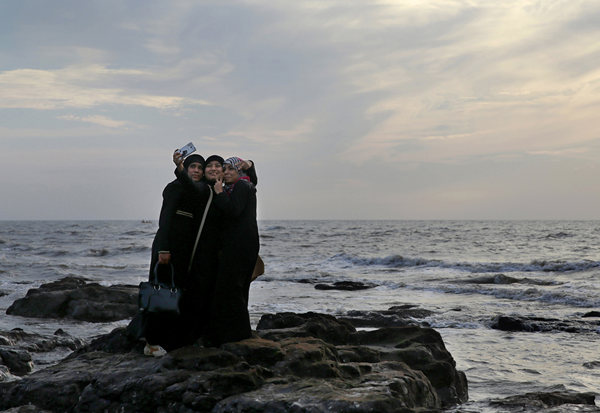Selfie-free zones set as deaths rise
Updated: 2016-02-26 03:30
(Agencies)
|
|||||||||
 |
|
Indian students take a selfie on Mumbai’s coastline on Monday. India is home to the highest number of people who have died while taking such photos in risky situations, with 19 of the world’s 49 recorded selfie-linked deaths since 2014. [Photo/Agencies] |
In any major Indian city, people are seen with an arm outstretched, mobile phone in hand, smiling widely and clicking away. Even Prime Minister Narendra Modi has embraced the selfie, posting pictures online that he's snapped with various world leaders.
But the pursuit of selfies can sometimes have lethal consequences. India is home to the highest number of people who have died while taking photos of themselves, with 19 of the world’s 49 recorded selfie-linked deaths since 2014, according to San Francisco-based data service provider Priceonomics.
The statistic may in part be due to India’s sheer size, with 1.25 billion citizens and one of the world’s fastest-growing smartphone markets. Nonetheless, alarmed by the trend, Mumbai has declared 16 no-selfie zones across the city, as authorities warn people against taking unnecessary risks.
Earlier this month, an 18-year-old college student on a class picnic lost his balance while taking a selfie atop a rock near a dam near the central Indian city of Nashik. He fell into the water and drowned, along with a classmate who jumped in to try to save him.
Last month, an 18-year-old woman fell and drowned in the sea while taking a photo of herself at Mumbai’s Bandstand Fort, a popular tourist spot.
An engineering student sustained fatal head injuries when a rock on which he was standing cracked and sent him tumbling. He’d been trying to take a selfie with friends in front of the Kolli Hills in Tamil Nadu.
In January 2014, three students ages 20 to 22 died when they stopped to take a photograph as a speeding train was approaching and were hit. They’d been on their way to visit the Taj Mahal.
In Mumbai, police have declared selfies off-limits in areas perceived as risky — particularly along the coastline in spots with no railings or barriers. Anyone venturing into off-limits areas, even if they take no photos, risks a fine of 1,200 rupees ($17.50).
The city's police conducted a survey to identify such dangerous places, police official Dhananjay Kulkarni said. Still, despite clearly marked signs demarking the selfie-free zones, people can still be seen clicking away, often going to the edges or standing on ledges.
Related Stories
Storms cause deaths, damages in 3 Brazilian states 2016-01-14 11:05
Extreme weather blamed for 442 deaths in Yangtze capsizing 2015-12-31 07:57
21 to stand trial for deaths in land disputes 2015-12-26 07:56
Fruit-flavored drugs to cut child TB deaths 2015-12-03 07:57
Abnormal deaths of officials should be checked for cause 2015-11-25 08:21
Today's Top News
Beijing edges NYC as home to most billionaires
110,000 refugees, migrants reach EU by sea in 2016
Tech giants reveal 5G innovations in Barcelona
Mechanism to be built to monitor ceasefire in Syria
London mayor says to support Brexit in EU referendum
What ends Jeb Bush's White House hopes
UK to hold EU referendum on June 23
US saber-rattling could spark arms buildup: experts
Hot Topics
Lunar probe , China growth forecasts, Emission rules get tougher, China seen through 'colored lens', International board,
Editor's Picks

|

|

|

|

|

|






